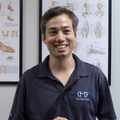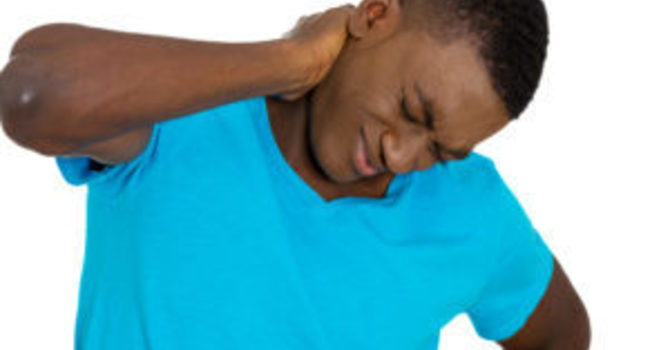
This can be a difficult question to answer, at first. It requires an understanding of the hip and back connection, a thorough history, physical exam, and at times, advanced imaging. The difficulty lies in their shared pain patterns. The hip and lower back have shared innervation, shared muscle groups, and shared functions.
The Hip and Lower Back Connection:
Since the hip and lower back have a shared innervation, muscle groups, and function; the pain patterns are also shared. What is known:
We can see there are overlapping similarities, but also some differences between the lower back and hip presentations. The next step is a thorough history and physical examination to determine if there is a lower back issue, a hip issue, or both. If it’s both, then it’s important to determine which one is primary and which one is secondary.
Hip and Lower Back Connection, Continued
The connection between the hip and lower back is very apparent in sports, especially in rotational sports like golf and tennis. The golf swing and the tennis stroke demand rotation from the lower back and hips. The correlation of the lack of internal hip rotation leading to excessive rotation and injury in the lower back in golf [Why is lower back pain so prevalent among golfers], tennis, and other rotational sports, has been made by researchers (Harris-Hayes, Vad et. al). In addition Nadler et. al, found that collegiate level athletes who showed muscle imbalance around the hips during the preseason, were more likely to suffer lower back pain within the year as compared to their counterparts, who showed muscle balance of the hip extensor, hip abductor, and hip adductor muscle groups.
Most of the research concerning the hip and lower back connection has been done on populations who already show arthritic changes to their hips and/or lower back. They’ve concluded that hip arthritis can lead to altered motion of the lower back and pelvis, which leads to arthritis of the lower back. However, the reverse order could also be true.
Younger athletes may not show signs of arthritis, but it can be speculated that hip or lower back dysfunction can progress into arthritic changes over time as part of a continuum, if not addressed. More research must be done to discover if the same continuum of degeneration is occurring when hip and lower back dysfunction is present in simple, less demanding tasks, such as activities of daily living.
History:
A thorough history can reveal a lot about the possible pain generators. It is a collection of data points that narrow down as best as possible, the following:
1. When and how the pain began (fall/trauma, repetitive motion/overuse, suddenly, insidiously, etc)
2. Location of the pain and its referral pattern
3. What movements and positions help relieve the pain
4. What movements and positions exacerbate the pain
5. What activities of daily living/sport affect the pain
6. What time of the day is the pain worse
7. The description and severity of the pain (e.g. burning, sharp, dull, sore, stabbing, aching, radiating, etc.)
Physical Exam:
The purpose of this, is to determine how the patient moves and functions in comparison to “normal/ideal”. The joint range of motion, tissue texture, tissue pliability, and nerve tension are considered during the physical exam. In addition, any aberrant movement patterns are looked at, as they can be either the cause or the result of the hip or lower back pain.
During the physical exam, certain specialized movement tests are used to try and isolate the hip from the lower back, and vice versa. This is a critical part of the examination, because if we can generate pain while loading one area without involving the other, it will give us a strong indicator of where the pain is originating from, or at least which one is primary and which one is secondary.
Advanced Imaging:
Imaging studies such as x-rays, ct-scans, ultrasound, and MRIs are the most commonly used for lower back and hip pain. The history and exam help determine what imaging needs to be done, and for what purpose. Most of the time, it is to confirm suspicions based on what the history and exam revealed. Other times, it is the next logical step when conservative care is not achieving the expected results. In either case, imaging is to be correlated with the physical exam findings. Many of us have asymptomatic arthritis in the hips and lower back and we should not assume that because arthritis is found on imaging, it is automatically our main pain generator.
Conclusion:
When it comes to lower back pain and hip pain, it’s important to differentiate between the two. However, we are also entitled to have both the hip and the lower back be an issue simultaneously, since one affects the other. Stuart McGill, a low back pain researcher, based out of Waterloo University, is quoted as saying “I’ve rarely see a lower back case that doesn’t also have a problem with their hips.” Although this may be true, it’s still extremely important to decide which one holds the highest priority: the lower back or the hip. By addressing and treating the key dysfunction you improve the lesser dysfunction because of their shared connection.
References:
Nadler, Scott F., et al. “The Relationship Between Lower Extremity Injury, Low Back Pain, and Hip Muscle Strength in Male and Female Collegiate Athletes.” Clinical Journal of Sport Medicine, vol. 10, no. 2, 2000, pp. 89–97., doi:10.1097/00042752-200004000-00002.
Harris-Hayes, Marcie, et al. “Relationship between the Hip and Low Back Pain in Athletes Who Participate in Rotation-Related Sports.” Journal of Sport Rehabilitation, vol. 18, no. 1, 2009, pp. 60–75., doi:10.1123/jsr.18.1.60.
Lee, Raymond Y.w, and Thomas K.t Wong. “Relationship between the movements of the lumbar spine and hip.” Human Movement Science, vol. 21, no. 4, 2002, pp. 481–494., doi:10.1016/s0167-9457(02)00117-3.
Murphy, Donald R, et al. “Pain patterns and descriptions in patients with radicular pain: Does the pain necessarily follow a specific dermatome?” Chiropractic & Osteopathy, vol. 17, no. 1, 2009, p. 9., doi:10.1186/1746-1340-17-9.
Redmond, John M., et al. “The Hip-Spine Connection: Understanding Its Importance in the Treatment of Hip Pathology.” Orthopedics, vol. 38, no. 1, Jan. 2015, pp. 49–55., doi:10.3928/01477447-20150105-07.
Vad, V.b., et al. “Hip and shoulder internal rotation range of motion deficits in professional tennis players.” Journal of Science and Medicine in Sport, vol. 6, no. 1, 2003, pp. 71–75., doi:10.1016/s1440-2440(03)80010-5.
©Dr. Daniel Yinh Center For Musculoskeletal Function 2018








